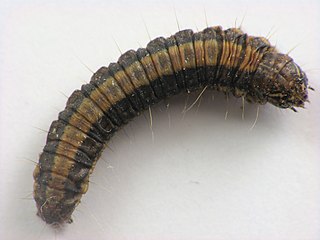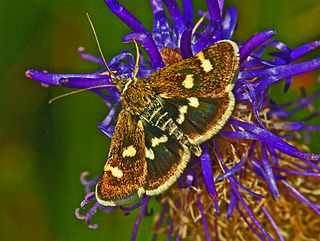Related Research Articles

Amasa Walker was an American economist and United States Representative. He was the father of Francis Amasa Walker.

Crambinae is a large subfamily of the lepidopteran family Crambidae, the crambid snout moths. It currently includes over 1,800 species worldwide. The larvae are root feeders or stem borers, mostly on grasses. A few species are pests of sod grasses, maize, sugar cane, rice, and other Poaceae. The monophyly of this group is supported by the structure of the tympanal organs and the phallus attached medially to the juxta.

Hypena is a genus of moths in the family Erebidae. It was first described by Franz von Paula Schrank in 1802. These non-migratory moths overwinter as pupae and almost never come to bait as adults.

Omiodes is a moth genus in the family Crambidae. Several species are endemic to Hawaii.

Macaduma is a genus of moths in the subfamily Arctiinae.

Syllepte is a genus of moths of the family Crambidae.

Eupitheciini is a tribe of geometer moths under subfamily Larentiinae, often referred to as pugs. The tribe was described by Tutt in 1896.

The Chrysauginae are a subfamily of snout moths. They are primarily Neotropical and include about 400 described species.

The Epipaschiinae are a subfamily of snout moths. Almost 600 species are known today, which are found mainly in the tropics and subtropics. Some occur in temperate regions, but the subfamily is apparently completely absent from Europe, at least as native species. A few Epipaschiinae are crop pests that may occasionally become economically significant.

Odontiinae is a subfamily of moths of the family Crambidae. The subfamily was described by Achille Guenée in 1854.
Macaduma albisparsa is a moth of the subfamily Arctiinae. It was described by George Hampson in 1914. It is found on New Guinea.
Macaduma borneana is a moth of the subfamily Arctiinae. It was described by Jeremy Daniel Holloway in 2001. It is found on Borneo. The habitat consists of lowland areas, including disturbed and coastal habitats as well as forests.
Macaduma castneogriseata is a moth of the subfamily Arctiinae. It was described by Rothschild in 1912. It is found in Papua New Guinea.
Macaduma biangulata is a moth of the subfamily Arctiinae. It was described by Jeremy Daniel Holloway in 1979. It is found in New Caledonia.
Macaduma subfoliacea is a moth of the subfamily Arctiinae. It was described by Rothschild in 1916. It is found in Volcan Island.
Macaduma montana is a moth of the subfamily Arctiinae. It was described by Robinson in 1975. It is found on Fiji.

The Cisthenina are a subtribe of lichen moths in the family Erebidae, currently containing 428 described species.
The Nudariina are a subtribe of lichen moths in the family Erebidae. The taxon was described by Carl Julius Bernhard Börner in 1920.
References
- ↑ Savela, Markku (ed.). "Macaduma tortricella Walker, 1866". Lepidoptera and Some Other Life Forms. Retrieved January 29, 2018.
| This Nudariina-related article is a stub. You can help Wikipedia by expanding it. |